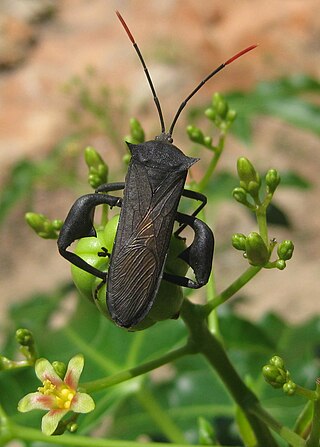
Coreidae is a large family of predominantly sap-sucking insects in the Hemipteran suborder Heteroptera. The name "Coreidae" derives from the genus Coreus, which derives from the Ancient Greek κόρις (kóris) meaning bedbug.

Pentatominae is a subfamily of Pentatomidae, a family of shield bugs. This subfamily is the largest one within the Pentatomidae, having 4937 species classified in 938 genera. Species in this subfamily are phytophages and several of them are considered agricultural pests. Some invasive pentatomines such as Halyomorpha halys and Bagrada hilaris have been considered household pests. Higher systematics of the group have been revised by Rider et al.
Acesines is a genus of Indian shield-bugs in the subfamily Pentatominae erected by Carl Stål in 1876.

Eurybrachidae is a small family of planthoppers with species occurring in parts of Asia, Australia and Africa. They are remarkable for the sophistication of their automimicry.
Afrania is a genus of African shield-bugs in the subfamily Pentatominae and tribe Strachiini, erected by Carl Stål in 1865.

Dictyopharidae is a family of planthoppers, related to the Fulgoridae. The family comprises nearly 760 species in more than 150 genera which are grouped into two subfamilies, Dictyopharinae and Orgeriinae.

Cryptotympanini is a tribe of cicadas in the family Cicadidae. They are found in the Nearctic, Palearctic, Indomalaya, Oceania, and Afrotropics.

Flatidae are a family of fulgoroid planthoppers. They are cosmopolitan in distribution and are distinguished from others in the superfamily by a combination of characters. Like all other planthoppers, they suck phloem sap of plants. Some species are known to communicate with vibrations through the plant stems. Communication may be with mates, or with ants that tend the nymphs, protecting them and gathering honeydew secretions. Adults of some species have brightly coloured forewings which are tougher and known as tegmina unlike the membranous hindwings which are used for flight. Although a few can be identified by their coloration, most species requires dissection and examination under a microscope with access to literature on already described species.

Scutellerinae is a subfamily of shield-backed bugs erected by Leach in 1815.

Dinidoridae is a small family of hemipteran "true bugs" comprising about sixteen genera and a hundred species the Hemiptera suborder Heteroptera. As a group the family does not have any common name. Until the late 19th century they were generally regarded as a subfamily of Pentatomidae.

Rhopalini is a tribe of insects in the subfamily Rhopalinae, family Rhopalidae, order Hemiptera.

Pentatomini is a tribe of shield bugs in the subfamily of Pentatominae.
Procilia is a genus of African shield bugs in the family Scutelleridae and the tribe Scutellerini described by Carl Stål in 1865.

Carpocorini is a tribe of stink bugs in the family Pentatomidae. There are more than 100 genera in Carpocorini.
Lineostethus is a genus of stink bugs in the family Pentatomidae and tribe Discocephalini; species are recorded from the Americas.

The Cicadini are a tribe of cicadas.

The Flatinae are a subfamily of planthoppers, erected by Maximilian Spinola in 1839. Genera have been recorded from all continents except Antarctica: especially in tropical and subtropical regions.
Oncochila is a genus of lace bugs in the tribe Tingini. Species are recorded from temperate Asia and Europe and includes O. simplex found in the British Isles.

The Phyllocephalinae are a subfamily of shield bugs erected by Amyot and Serville in 1843.

The Discocephalinae are a subfamily of shield bugs, erected by Fieber in 1860, and found mostly in the Americas.














